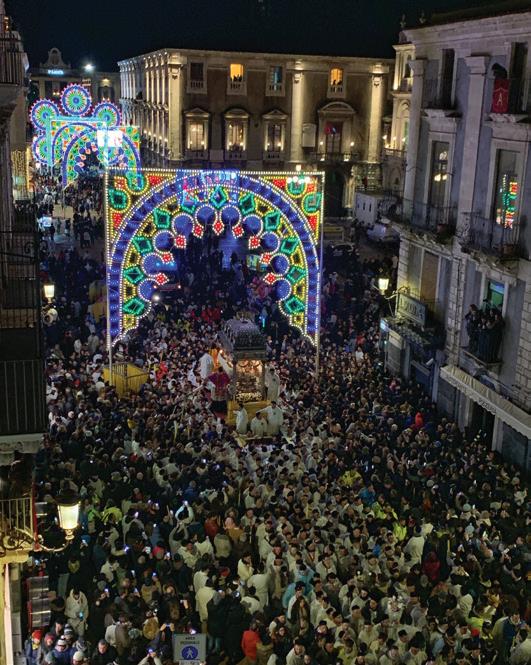
4 minute read
Sant’Agata Festival to be Held in Catania Feb. 3rd - 5th

The annual “Festa di Sant’Agata” (Saint Agatha Festival) is by far the most impressive religious festival held annually in Sicily. Featuring processions, holy masses concerts and amazing fireworks, it takes place in city’s the historic center from Feb. 3 through 5.
Photo by Andriana Genualdi
By Alberto Lunetta, NAS Sigonella Public Affairs
Advertisement
After a year of preparation, Catania townspeople are ready to celebrate “La Festa di Sant’Agata” (Saint Agatha Festival) the third largest Catholic festival in the world. The festival, which is preceded by a month of preparatory events, features three days of massive festive processions and events which will take place February 3-5 in the historic heart of Catania.
“Semu divoti tutti? Cettu, Cettu, Citatini, viva Sant’Aita!”(Are we all devotees? Yes, of course, sure, Townspeople, long live St. Agata)!” Devotees will repeatedly scream those passionate words during the processions until they get a hoarse voice as a demonstration of their devotion to the beloved patroness. These celebrations which mingle the sacred and profane, will involve hundreds of thousands of Catanians who will swarm the streets of the historic center to pay homage to the statue of the “Santuzza,” or young saint (St. Agata’s nickname given because of her young age).
This must-see event, which only happens once a year, attracts thousands of Divoti (devotees) to defy bad weather conditions to see her while she is brought in procession.
According to an ancient, tradition, Saint Agata is considered a salvatrice (saviour), which alleges she rescued Catania several times over the centuries, especially during earthquakes and volcanic eruptions.
Legend has it that her holy purple-colored veil (named “limpia” in Sicilian) stopped two dangerous eruptions. The first of which occurred in 251 AD, a year after her martyrdom, and the second in 1886, when the lava threatened Nicolosi. In both cases, the veil was brought in procession to the eruption site and the advancing lava flow miraculously stopped.
The holy veil is 13 feet long by 20 inches large. Three golden threads decorate its extremities. According to legend, the veil, which was originally white, covered the head of Saint Agata when she was rolled over live coals during her martyrdom. As a result of this torture, the “limpia” remained miraculously undamaged by the fire and turned red. Since then the veil has been venerated as a defense against Etna eruptions.
Catanians have been celebrating this festival since 1519. For centuries, there has been a long-running controversy between Catania and Palermo over where she was born, but it looks like Catania won the debate.
Every year, a stream of devotees of all ages will crowd the streets dressed in white tunics (historically women would wear green, though today many female devotees wear white), called “saccu” in Sicilian, gloves, a handkerchief, and black skullcap (in Sicilian, “a scuzzitta”).
According to tradition, the saccu symbolizes the nightdress which Catanians wore when the Saint’s relics returned from Turkey on Aug. 17, 1126.
History recounts it was a great feast for the Catania community whose residents demonstrated their enthusiasm by waiving white handkerchiefs. Other historic accounts link the white tunic tradition to both the ancient Egyptian Goddess Isis or more recently, the penitential garment worn by priests.
Life of Sant’Agata
According to tradition, Agata came from a rich family. Her virtues and her beauty drew the attention of Quintianus, a local Roman governor who actively and brutally persecuted Christians.
Agata, who already consecrated herself to God, refused his advances. Therefore, Quintianus decided to punish her by having her locked up in a brothel where Aphrodisia, a wicked woman, tried to corrupt Agata’s virtue and faith by playing wiles and stratagems. Agata never wavered and resisted to all her attempts.
Quintianus, miffed by Agata’s firmness, had her undergo terrible tortures such as cutting off her breast. This detail was often depicted in the Christian medieval paintings as a peculiar characteristic of Saint Agata.
Tradition also tells about prodigious events that occurred while Agata was in prison such as the apparition of St. Peter who comforted and healed all her wounds. Eventually, after repeated tortures Quintianus had Agata condemned to the stake. While she was burning alive a violent earthquake struck Catania. This natural disaster was welcomed by the Catanians as a sign of God who wanted the tortures inflicted to Agata to be over. Thus, a riot broke out in the city forcing Quintianus to stop the infamous execution. Agata was then brought back to her prison where she died right after. It was Feb. 5, 251 AD. Later on the same day Quintianus fled the city, out of fear of the riot, and drowned in the river Simeto.
- Traditional Sweets -
Cassatine: small breast-shaped cassate pastries filled with ricotta cheese, covered by sugar glaze, with a candied cherry on top.
Olivette di Sant’Agata: Olivette (Olive-shaped and green marzipan sweets). Olivette are also available in a chocolate covered version.
Torrone: A nougat made with sugar, honey, egg whites, almonds and hazelnuts.
- In the Procession -
Vara: is a 16-foot long richly decorated silver float on which the bust depicting Saint Agata and several crystal and silver caskets containing her relics (legs, arms and other bones) carried in procession.
Cannalori: are tall wax candles surrounded by a heavy (up to 1,500 pounds) candelabrum-shaped gilded wooden structure. They are decorated with statues depicting angels, saints, pennons and flowers. Scenes from the Saint Agata martyrdom are also carved on their sides. Each Cannalora represent a city’s guild such as butchers, greengrocers, fishmongers, pasta makers, bakers and more.
- More Information -
As you attend the festival, be sure to also visit the annual Fiera di Sant’Agata or Saint Agatha’s Fair which will be set up at the Villa Bellini (public gardens) from February 2 through 6. For more information and festival’s details, visit the following web sites:
www.festadisantagata.it
www.circolosantagata.it
www.facebook.com/festadisantagatact/
www.cattedralecatania.it






